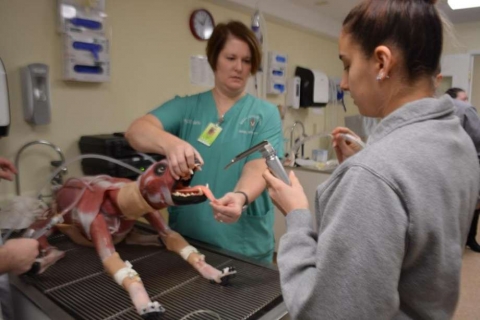Middlesex Community College’s veterinary tech students among 1st in U.S. to practice on synthetic cadaver
MIDDLETOWN — Deanna DeMatteo, a second-year veterinary technology student at Middlesex Community College, ties a neat bow, securing the endotracheal tube she has just inserted in the mouth of her canine patient.
As heart and other monitors beep steadily in the background of the simulated operating room at Pieper Veterinary Thursday morning on Randolph Road, DeMatteo, of Branford, injects anesthesia into the intravenous port in the dog’s forefoot as her instructor watches.
While her patient is splayed out on the operating table, DeMatteo attaches a bright blue breathing bag to the endotracheal port and begins to slowly and steadily squeeze air into the dog’s lungs. She’s working under the guidance of Pieper Veterinary Dr. Christopher Liguore and Chris Gargamelli, assistant professor/program coordinator of veterinary science.
It’s the students’ third day using the practice dog.
The patient here is a cadaver — a synthetic surgical canine, or SynDaver , to be precise — and Middlesex is one of only four veterinary technology schools in the country to have use of one.
“It’s actually more realistic than a cadaver because it mimics pumping blood, which a cadaver would not do, and so much more,” Gargamelli said.
The cost — $35,000 — was entirely paid for by a federal Perkins Grant. Pieper has classrooms for MxCC vet students, offers internships and, very often, employs these graduates, who earn an Associate of Science degree in veterinary technology after two years.
The MxCC vet tech program has a 100-percent job placement rate, Gargamelli said.
Scooby the SynDaver (the company uses names rather than serial numbers) will soon have its own personalized name after members of MxCC’s vet tech club hold a contest.
In veterinary schools, students always begin their training on cadavers, Gargamelli said. This life-size, anatomically correct synthetic cadaver allows students to perform routine procedures without risk to a live animal, and once worn out, each part is fully replaceable. In fact, Gargamelli said, the Perkins grant includes enough funding to replace parts for up to five years.
The SynDaver’s bones are made of a plastic that contains chemicals which allow the bones to show up under x-ray, Gargamelli said, as a vet tech student applies gel to the area of the dog she’s readying for an ultrasound.
Liguore, an intern, watches her carefully.
“Our interns are doctors. They’ve finished their schooling and have chosen to come to a hospital like Pieper to enhance their education, possibly pick a specialty, and then work within that specialty,” said Marketing Manager Jesse Ferguson.
Liguore, who said he loves the surgery team, rotates between neurology, oncology, radiology and emergency room work.
“I do the whole thing,” he said. “It’s almost like a human internship. I don’t have primary cases, I’m mostly here for the specialty services like the ER. I can manage my own cases, but there are always experienced ER doctors that are there to walk us through cases.”
The synthetic dog’s abdomen unbuttons to reveal internal organs, some of which have unknown ailments veterinary students discover through their examinations, Gargamelli said.
DeMatteo, who is training now in farm animals but wants to eventually specialize in caring for zoo animals, said the SynDaver allows her to practice much more than she would be able to otherwise.
“Cadavers are useful to see the real organs, but this is good, too, because it gives you real-life situations and it’s easier to feel the pulse and try and get blood,” said DeMatteo, who up until now has only worked with cadaver cats. “It’s a real fake dog. With a cadaver, you can look at the organs, where the parts are, and learn the anatomy. This, you actually learn where the pulse is, and how to draw blood, and put catheters in.”
If the SynDaver were a live dog, Gargamelli said, it would have gotten an injectable anesthetic prior to the procedure, “and that would make it under enough anesthesia to intubate it, then it would be hooked up to anesthetic gas to maintain it,” he said.
When SynDaver first launched as a company, it was making synthetic human cadavers for medical students. Gargamelli was at a veterinary conference, saw the dog model, and knew immediately he wanted to bring it back to his students.
“This is the only thing I’ve ever wanted to do,” said Gargamelli, who knew since age 5 that he wanted to be in the field. “I love teaching. I have a great relationship with the students. We really have a lot of fun. I teach anatomy and physiology, so I’ll bring in the cases I saw over the weekend. It’s really a great relationship to be able to tie in what I do clinically and to be able to bring it back to the students.”
The MxCC vet tech program is geared toward one goal, he said.
“At the end of the day, when these students graduate, I want them to be able to go into a vet hospital and be useful to the vet they are working with,” Gargamelli said.
Gargamelli grew up having dogs and cats, and his uncles raised homing pigeons. At 16, he got his first job at a veterinary hospital.
“Petting a dog or cat and doing this are two completely different things,” he said. “I had to make sure it was for me. That happens, too, with our vet tech students.”
The MxCC program can accept a maximum of 24 student per year. And it’s very competitive. Last year, more than 40 applied. The first class graduated last spring.
The relationship between the vet hospital and college is a symbiotic one: Pieper provides a clinical setting and educators, while MxCC offers lectures, organization, logistics and supplies, Gargamelli said.
“We’re a big education hospital,” Fergson said. “We educate our own staff, we have a phenomenal intern program, we offer continuing education to veterinarians in the area, and we love having a school support that is turning out amazingly trained techs.”
A lot of the MxCC vet students also intern at Pieper, which boasts 250 employees, an emergency room and four general practices, Ferguson said. Soon, it will open a second ER in Madison.
Over last two to three decades, there has been an interesting shift in society, Gargimelli said.
“If you watch the TV shows from the 1950s 1960s, the dog is always outside living in the dog house. Now they are companion animals, they live inside the house with us,” he said. “That shift led to animals being viewed as family members, and, with that shift, came the desire that people want health care for their animals.”





